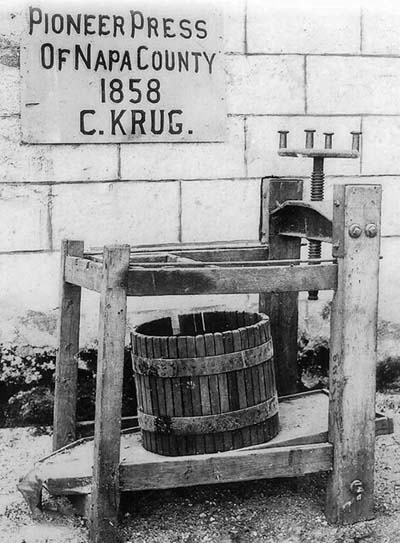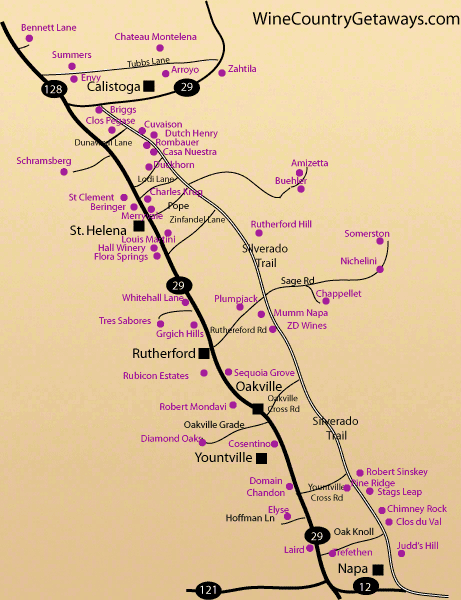The History of Napa Valley Wine
The United States is the fourth largest producer of wine in the world, with California producing 89% of all the wine in the country. And in California, Napa Valley is the most celebrated wine region of them all. Interestingly, while Napa Valley produces only 4% of California’s wine and is the smallest of all wine regions in the country, it is the most diverse of all.
Napa Valley received official recognition as a producer of high-quality wines as well as for having unique regional terroir in 1981. It became California’s first AVA (American Viticultural Area).
However, the region’s wines had already gained worldwide fame, when it beat French wines in blind tastings in both red as well as white categories in 1976’s Paris Judgement. The two Napa Valley wines that won the day were Chateau Montelena Chardonnay and the Cabernet Sauvignon from Stag’s Leap Wine Cellars.
So, what makes Napa Valley so special? When did wine production begin in the region? Why has Napa Valley become so famous and such a big tourist attraction today? Here are the answers to all these questions, and more.
When was Wine First Grown and Produced in Napa Valley?
Many people view the 1976 Judgement in Paris as a landmark moment for the wine growers of Napa Valley. However, the region’s love affair with wine and grapes started a long time before that. All the way back to the early 1800s, in fact.
Wild grapes had always grown in abundance in Napa Valley however, it was in 1839 that the true history of wine-making in the region began. Settler George Yount, the first person of European descent to have settled in Napa Valley, was also the first person to being planting grapes here.
Yount, originally a fur trapper, was given the land he first started cultivating grapes on as a grant from the Mexican government. At the time, California had not yet been awarded statehood, and was still a part of Mexico. Today, Yountville, the small town named after him, is famous for its gourmet cuisine, and is home to two Michelin-starred restaurants.
Despite the fact that Yount was the first person to seriously start planting vines in Napa Valley, he did not grow in the industry.
Yount’s first neighbor, an Englishman named Edward Bale, also planted mission grapes on his land, but like Yount, did not spend too much time developing his vineyards.
Then, in 1859, Samuel Brennan bought over 2000 acres of land. He named the area Calistoga in 1867. He planted more than 100 acres of vines on this land, but once again, he did not seriously focus on developing them.
Who Were the First Wine Producers in Napa Valley?

Despite all these people planting grapes in Napa Valley, it was John Pratchett who has been credited with building the first official vineyard and winery in the region. In 1854, Pratchett began planting vines, and just 3 years later, in 1857, he began producing wine.
The wine making industry was so young in California at the time that there was no wine press available. So, Pratchett and his wine maker used an old cider press to make their wine.
In 1859, Pratchett built his first wine cellar, and the very next year, he received his first official review. It was also the first ever review of a California wine. The review was composed by Robert Parker, and it stated that the white wine was clear, light and brilliant, and of very high-quality. Parker also praised the wine maker’s red wine, saying it was excellent.
Pratchett’s wine maker was Charles Krug, who, a few years later, started his own winery.
And it was Charles Krug who changed the face of wine making in Napa Valley. He established the region’s first commercial winery in 1861, which led to a wave of new vineyards and wineries being created across the valley. Over the next 20 years, over 140 wineries were established, of which Beringer Vineyards, Inglenook, and Schramsberg Vineyards are still in operation today.
Sadly, in the 1890s the root louse phylloxera infected Napa Valley’s vineyards, killing off more than 80% of the vines. For the next 35 years, phylloxera continued to plague Napa Valley. People turned to walnut and prune farming to survive.
Things got even worse when Prohibition came into effect in 1920. Over the next 13 years, most of the wineries that had survived years of battle against phylloxera lost their battle to the government. Only a few – Beringer Vineyards and Louis M Martini, to name a couple – survived by making sacramental wines for the churches.
By 1933, Prohibition was lifted and Napa Valley began its slow road to recovery. In 1944, 7 wineries joined hands with the aim of making the best wine possible. They created the Napa Valley Vintners Association and signed a treaty of collaboration. Today, this association represents 525 wineries in Napa Valley and raises more than $15 million annually to help the local community.
Over the next four decades, the Napa Valley wineries reinvented themselves. Inglenook, which had shut down, was re-established. Beaulieu Vineyards was also re-established by Georges de Latour. The Mondavi family bought out the Charles Krug Winery and built their wine-making empire, and Louis M Martini founded his famous Martini brand.
It was during this time Andre Tchelistcheff revolutionized the process of wine making at Beaulieu Vineyards. Napa Valley’s name is now synonymous with luxury wines and is a famous tourist destination.
Today, Napa Valley is home to almost 500 wineries, of which 95% are family-owned. The wine industry in this region produces over 1,000 different brands of the highest-quality wines, and generates nearly $50 billion in yearly revenue.
The wine industry is the largest employer in Napa Valley, and the vintners believe in sustainable agricultural practices and environmental protection. Wineries follow green business practices to ensure sustainability. The government has also supported Napa Valley’s efforts and almost 90% of the land in Napa County is protected from development.
What Makes Napa Valley Such a Great Region for Wine Making?
Napa Valley is just one-sixth the size of Bordeaux, but it has great diversity. The terrain has many peaks and dips, with valleys that are at sea level as well as mountains that rise up as high as 2,000 feet.
Napa Valley is just 50 miles north of San Francisco. The region starts at its southern end with the city of Napa, and this part of the valley is quite cool. From Napa, the valley’s wine region runs 30 miles northwest to end at the city of Calistoga, where sizzling temperatures often reach higher than 100°F.
To the east and west are the Vaca and the Mayacamas mountain ranges, and it is these two mountain ranges that not only offer the slopes for grape growing, but also play a huge role in influencing the climate of the region. The Vaca protects the region from the intense heat of Central Valley, and the Mayacamas shield Napa Valley from the colder airs of the Pacific Ocean.
Only 2% of the world experiences a perfect Mediterranean climate, and Napa Valley is a part of that 2%. The long grape growing season is characterized by warm, sunny days that are interspersed with cool foggy nights. These steady rises and falls in temperatures allow the grapes to ripen slowly, which is what gives them the high quality that the Valley has become renowned for.
Added to that, different parts of the Valley have their own microclimate; it’s cooler in the south and warmer in the north. And this allows cultivation for a greater variety of grapes in the region.
Despite the fact that Napa Valley is just about 30-miles long, there are dramatic variations in climate, especially in the summer months. You can experience a 10°F to 15°F temperature difference from one end of the region to the other!
Added to that, the area’s soil is amazingly diverse. Geological studies have shown that this region is made up of over 100 variations of alluvial, volcanic as well as maritime soil. Soil patterns here range from clay and gravelly loam to thin and rocky.
Did you know that more than 50% of the soils that exist on our planet can be found in this one single region? For growing good wine grapes, diversity in the soil is key. The more diverse the soil, the better the vines grow.
And one of the soil types has gained a lot of fame in Napa Valley – Rutherford Dust. This is the alluvial soil found in the benchland in middle of the valley, and it is this soil that is responsible for the Valley’s high-quality Cabernet Sauvignon. In the north, the more volcanic soil allows for the growth of the famous Cabernet grapes. And in the south, the soil is rich in calcium, which is perfect for growing pinot noir grapes.
Because of these climatic, geological and topographical conditions, Napa Valley is home to more than 3 dozen different grape varieties.

Thanks to the diversity of the region, not only does Napa Valley have its own AVA within the North Coast AVA, but it also has 16 sub-AVAs within its 30-mile radius. The list of AVAs in Napa Valley are:
- -Atlas Peak
- -Calistoga
- -Coombsville
- -Chiles Valley District
- -Diamond Mountain District
- -Howell Mountain
- -Mount Veeder
- -Los Carneros
- -Oakville
- -Oak Knoll District of Napa Valley
- -Rutherford
- -St. Helena
- -Spring Mountain District
- -Wild Horse Valley
- -Yountville
What Types of Wines are Grown in Napa Valley?
Even though Cabernet Sauvignon and Chardonnay are the two most popular varieties of vine planted in Napa Valley, there are actually more than 3 dozen wine grape varieties that are grown here. Here are some of the most popular wine grape varieties that are grown in the Valley:
Red Wines
Napa Valley is world famous for its red wines. And of all the red wines produced in the region, here are the most popular.
Cabernet Sauvignon: The wines that Napa Valley is most famous for are its blends of Cabernet Sauvignon and Cabernet. And despite the fact that these two varieties of grapes are grown in many parts of the world, only the Bordeaux region in France and Napa Valley produce the best wines of this category.
Napa Valley has 18,200 acres of land dedicated to the cultivation of Cabernet Sauvignon, which is about 60% of the region’s wine crop. The interesting thing is that the style of the grape varies depending on which part of the Valley it has come from.
Grapes grown on hillside vineyards produce wines that are full-bodied and robust, and have strong flavors, rich tannins and deep, dark colors. Those grown in the valley floor are usually medium-bodied and have mellower tannins, with lower concentrations of flavor as compared to their high-altitude cousins.
Merlot: This variety is the second most produced in Napa Valley. It is either made as a varietal wine, or blended in small amounts with Cabernet Sauvignon. The Merlot is a widely used blending grape within the region and has been since the 1970s.
Pinot Noir: Pinot Noir is Napa Valley’s third most popular grape, and it is grown primarily in the region’s coolest district, Carneros. This grape is vinified for both sparkling and still wines.
Zinfandel: Napa Valley produces the original red version of Zinfandel and it is the fourth most produced wine here. Zinfandel is the grape that is most closely associated with the state of California.
Shiraz/Syrah: This variety of grapes is produced in many parts of the world, and the Shiraz/Syrah produced from them are powerful and have great aging potential.
Petiet Sirah: For the longest time, it was thought that this grape was a variant of Syrah that had smaller berries. However, DNA testing showed that Petite Sirah was actually a seperate grape variety called Durif.
Blended Wines: There is a rising trend in Napa Valley for blending wines. In fact, 3 of the region’s best red wines, Rubicon, Opus One, and Dominus, are red wine blends made largely from Cabernet Sauvignon. Other wines used in the blending include Cabernet Franc, Merlot and occasionally Malbec or Petit Verdot.
White Wines
Napa Valley’s white wines are as popular as their red wines and are also of the highest quality.
Chardonnay: Chardonnay grapes are the most popular variety to produce white wines in Napa Valley. About 7,300 acres of the Valley are dedicated to the production of this variety of grape.
Chardonnay is an ancient grape variety that has descended from Pinot Noir and Gouais Blanc, and this is one wine grape that is known to take on the properties of its terroir.
Chardonnay is grown in the cooler southern regions of the Valley, and it yields a varied spectrum of wines with an interesting range of styles. You will get Chardonnays that are rich and opulent, and you will also get those that are lean and zippy.
Sauvignon Blanc: This the Valley’s second most produced white wine and it is sometimes labeled as Fumé Blanc.The wine got its second name in 1968, when Robert Mondavi created its double-identity.
This wine grape is slowly gaining a lot of popularity in Napa Valley. At this time, Sauvignon Blanc, along with Chardonnay, comprise 90% of the Valley’s white wine grape plantings.
Pinot Grigio/Gris and Viognier are the latest addition to the white wines being produced in Napa Valley and have been doing very well. Both Pinot Grigio and Viognier have been eating into Chardonnay’s market share and increasing diversity in the market.
Blended Whites: As with the red wines, blended white wines are also a favorite in Napa Valley. Once again, the region uses grape varieties that are most popular in France for creating their blends – Sémillon and Sauvignon Blanc.
Other Varieties
Besides these popular varieties, Napa Valley also grows Petit Verdot, Sangiovese, Riesling, Chenin Blanc, and Muscat, among others.
Napa Valley has always been known as a place where vintners experiment with different varieties of grapes. So, you can even find obscure grape vines such as Albarino and Charbono in the Valley’s vineyards.
Why is Napa Valley Such a Tourist Destination Today?
Napa Valley has been a cosmopolitan area for over a century, and it has a diverse population of people hailing from different parts of the world. In the old days, gold miners would come to this valley to spend their winters. And before roads and cars, people would travel down the Napa river to the city of Napa.
There were steamboat ferries that would regularly carry the residents of San Francisco to Napa Valley for holidays and weekends. And when the railroad was established in 1868, it only served to increase the number of visitors to this area.
The Valley’s history is replete with stories of grand parties being held for the aristocracy in the huge mansions that graced the region. It was known as a high culture destination then, and that moniker is still applicable today.
Napa Valley today is a center for gourmet cuisine and fine arts. But more than that, it is the destination for wine tourism in America.
The Valley is on that 2% list of places that have the perfect Mediterranean climate. The summer months, which last from May to September, are warm and dry, and are moderated by cool fogs that flow down from the Pacific Ocean in both the southern as well as northern ends of the region. This makes the nights cool, but not cold.
It only rains in the winter months from November to April, a time that is called Cabernet Season in the Valley.
The Valley sees more than 3.5 million visitors every year, and over 90% of them have stated that they loved the hospitality they experienced. These visitors come for the wines that have made Napa Valley so famous and they are treated to the best of everything.
Lodgings can range from quaint Bed and Breakfasts to luxury resorts, and the food is an explosion of culinary delight. In fact, there are more Michelin-starred restaurants per capita in Napa Valley than any other wine-growing region in the world. Chefs vie with each other to create food that can complement the luxury world-class wines that are produced here.
And while there are a ton of things to do in Napa Valley, such as hiking, hot air ballooning, golfing, kayaking, canoeing, visiting the theater, doing the round of bars and clubs, shopping, visiting the art galleries, visiting the Farmers’ markets, spa treatments, and sampling the delicious food, most of visitors who come to the region come for the wine tours and sampling the Valley’s stunning wines.
In fact, 81% of all visitors who travel to Napa Valley opt for the wine tasting at wineries, another 45% go on winery tours, 20% visit stand-alone wine tasting rooms, and 27% take the Napa Valley Wine Train. The data also showed that nearly all visitors, in fact, 97.2% of them, visited at least one winery during their visit to Napa Valley.
To build on its wine tourism, Napa Valley also hosts numerous events throughout the year, such as the Calistoga Harvest Table, the Grape Stomp Competition, the Harvest Celebration, and so on.
Despite the fact that Napa Valley is not a cheap tourist destination, people keep coming back to it. In fact, data shows that almost 51.4% of the visitors to Napa Valley are repeat visitors.
Tourism is the second biggest employer in Napa Valley, and it supports the livelihood of almost 16,000 people in the community.
Thanks to the wine tourism industry, $2.23 billion in revenue was generated in 2018 alone. The Napa Valley government is expecting tourism to grow exponentially over the next few years as the wine tourism, which has so far been a niche in the industry, becomes more popular and more people want to enjoy the delights of a wine tasting experience.
Recent Posts
-
Essential Wine Guide: Top Tips for Selecting, Tasting, and Enjoying Your Bottle
Picking the right wine can be a sensory quest as rich as the flavors in your glass. Navigate the lan …Apr 18th 2024 -
The Ultimate Wine FAQ Sheet
Do you have some burning wine questions that need answering? We're here to help!Let's get straight t …Mar 19th 2024 -
A White Wine Food Pairing Guide To Make Every Meal Exceptional
A meal is only complete once you have the ultimate wine pairing to go with it. Red wine is excellent …Feb 6th 2024




